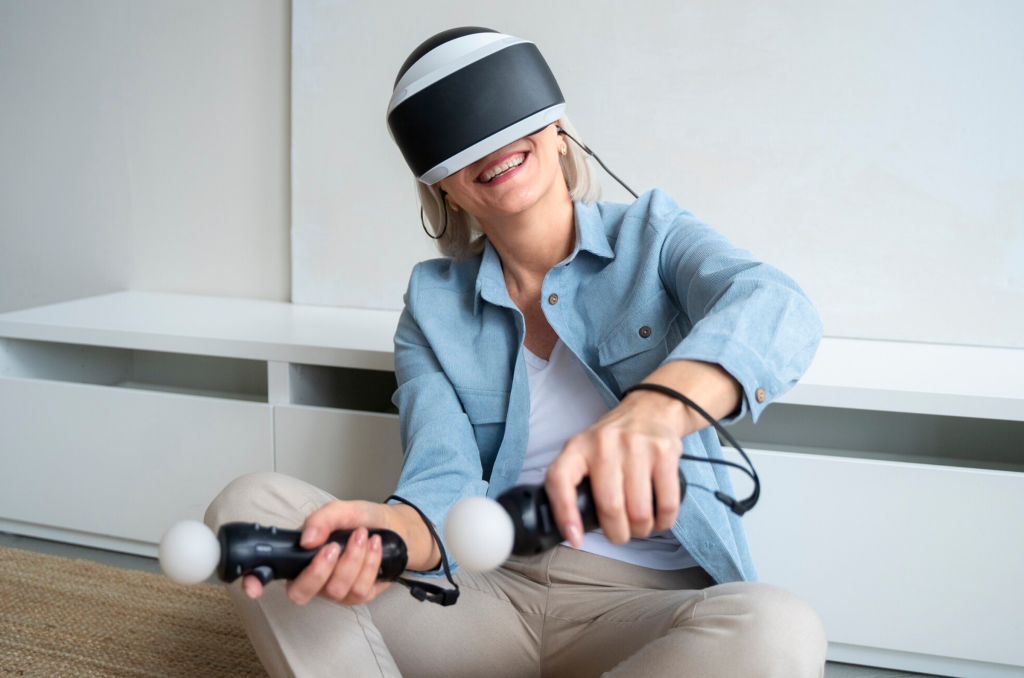Virtual reality (VR) is no longer just for gaming and entertainment. Today, it’s carving out a revolutionary path in the world of therapy and rehabilitation—bringing immersive, personalized, and science-backed care to patients around the globe. From treating PTSD to helping stroke survivors regain motor skills, VR is becoming a powerful ally in modern healthcare.
Let’s dive into how this technology is transforming traditional treatment models and what the future holds.

🧠 What Is Virtual Reality Therapy?
At its core, virtual reality therapy uses simulated 3D environments to deliver controlled, interactive treatment experiences. These simulations are designed to mimic real-world scenarios or introduce therapeutic settings where patients can safely explore, practice, or confront challenges.
VR therapy is commonly used in:
- Mental health treatment (e.g., anxiety, PTSD, phobias)
- Physical rehabilitation (e.g., after strokes, injuries, or surgeries)
- Pain management
- Neurological retraining
Unlike conventional therapy settings, VR allows for repetitive, engaging, and adaptive experiences tailored to each patient’s pace and progress.
💡 Why VR Is Gaining Ground in Healthcare
Several factors make virtual reality an attractive solution in modern therapy:
1. Immersive Engagement
VR creates a distraction-free, immersive experience, increasing focus and participation. This is particularly helpful for patients who struggle to stay motivated during traditional therapy sessions.
2. Customizable Treatment
Therapists can fine-tune scenarios in real time—adjusting difficulty, stimuli, or environment based on a patient’s condition and progress.
3. Real-Time Feedback
Sensors and tracking systems allow therapists to monitor movement, reaction time, and accuracy, providing immediate feedback for both the practitioner and the patient.
4. Safe Exposure
In mental health therapy, VR enables exposure to feared or stressful situations in a controlled, safe setting, which is critical in treating conditions like PTSD and social anxiety.
🧍♂️ Applications of VR in Therapy and Rehab
🧠 1. Mental Health: Tackling PTSD, Anxiety, and Phobias
VR therapy has shown incredible promise in helping individuals confront trauma or phobias through exposure therapy. By simulating triggering environments in a controlled space, therapists can gradually help patients desensitize and reprocess their experiences.
📚 A study from the Journal of Anxiety Disorders (2021) found that VR exposure therapy was as effective—or even more effective—than in-person exposure therapy for social anxiety disorder.
🏃♀️ 2. Physical Rehabilitation: Regaining Motor Control
For patients recovering from strokes, spinal injuries, or orthopedic surgeries, VR-based physical rehab adds a layer of motivation and interactivity to traditional exercises.
In practice, this can look like:
- Reaching for floating virtual objects
- Walking through a forest trail simulation
- Completing tasks that mimic daily living skills
📚 Research published in Frontiers in Neurology (2020) highlighted that VR-assisted physical therapy improved balance and mobility in post-stroke patients more effectively than traditional approaches.
💥 3. Pain Management
Pain is not just physical—it’s neurological and emotional. VR can help redirect the brain’s attention, reducing perceived pain intensity during and after treatments.
Hospitals are using VR for:
- Burn victims undergoing wound care
- Chemotherapy patients
- Chronic pain sufferers
📚 Cedars-Sinai Medical Center found that VR use led to a 24% drop in pain scores among hospitalized patients, simply by immersing them in calming, distraction-rich environments.
🧬 Emerging Use Cases and Trends
VR therapy continues to evolve, with exciting developments in:
- Cognitive rehabilitation for Alzheimer’s and dementia
- Addiction recovery programs that simulate high-risk situations
- Autism spectrum disorder support, enhancing social interaction training
- Tinnitus desensitization, using audio-visual retraining
Moreover, AI integration and biometric feedback tools are making it possible to adapt VR sessions dynamically, based on real-time emotional and physiological data.
🧭 Benefits for Patients and Practitioners
| Benefit | Description |
|---|---|
| Increased Motivation | Gamified rehab boosts consistency and enjoyment |
| Greater Accessibility | Remote VR therapy options are growing, especially in rural areas |
| Personalization | Sessions can be customized by progress, condition, and comfort level |
| Measurable Progress | Quantitative data helps track recovery and adjust care plans |
⚙️ Challenges and Considerations
Of course, there are some hurdles to address:
- Cost of equipment and platform development
- Limited access in low-resource or rural areas
- Motion sickness or discomfort for some users
- Training requirements for healthcare professionals
Still, as hardware becomes more affordable and software more user-friendly, these barriers are steadily lowering.
🧭 What’s Next for VR in Therapy?
Looking ahead, we’re likely to see:
- Wider insurance coverage for VR-based treatments
- Integration with wearable devices for biofeedback
- Therapist-guided VR sessions via telehealth platforms
- Social VR environments for group therapy or community support
As more clinical trials validate the efficacy of VR in therapy, adoption rates across hospitals, clinics, and wellness centers are expected to surge.
🧠 Final Thoughts
Virtual reality is proving to be much more than a tech trend—it’s a therapeutic tool with life-changing implications. Whether helping a veteran process trauma or guiding a stroke patient through recovery, VR is reshaping the possibilities of healing.
For healthcare providers and patients alike, the message is clear: the future of therapy is immersive, intelligent, and deeply human.
📚 References:
- Freeman, D. et al. (2017). Virtual reality in the assessment, understanding, and treatment of mental health disorders. Psychological Medicine.
- Cedars-Sinai Medical Center. (2019). Study: VR Helps Reduce Pain in Hospital Patients
- Laver, K. et al. (2020). Virtual reality for stroke rehabilitation. Frontiers in Neurology.
- Maples-Keller, J.L., Bunnell, B.E., Kim, S.-J., & Rothbaum, B.O. (2017). The Use of Virtual Reality Technology in the Treatment of Anxiety and Other Psychiatric Disorders. Harvard Review of Psychiatry.






